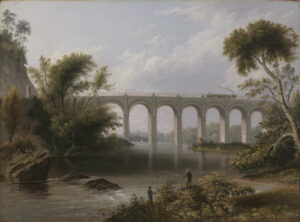
Very Virginia: Interactive Exploration
Discover Virginia’s rich history through art! By observing and discussing art objects, learn about significant people, places, and events throughout the Commonwealth’s history.
Physical Geography and Native Peoples
Virginia is made up of a diverse landscape. It can be divided into five geographic regions: Coastal Plain (tidewater), Piedmont, Blue Ridge Mountains, Ridge and Valley, and Appalachian Plateau. The first Virginians arrived around 15,000-20,000 years ago and over time developed distinct and diverse cultures. Virginia Indians belong to three major language groups: Algonquian, Iroquoian, and Siouan. Today, there are 11 state-recognized tribes.
This piece by Molly Murphy-Adams is called Map: Commonwealth Project. Instead of drawing the map on paper, Murphy-Adams used fabric and beads to sew together the map and its embellishments. Around the map are six panels with different designs. Each panel includes a QR code made of beads which when scanned, contains information about different Virginia rivers. The black and white design on the outside of the panel illustrates traditional basket patterns of Virginia natives and the other patterns are different tattoo designs. Get a closer look at the details in the map and then discuss these questions:
- Why do you think the artist chose to show Virginia with all its different boundaries? What might that say about Virginia’s history?
- Why do you think Murphy-Adams chose to focus on rivers of Virginia? If you made a map of Virginia, what would you focus on and why?
- Beadwork is an art form used by many indigenous cultures for hundreds of years. What might the artist be saying by combining an old art form with modern technology?
Map: Commonwealth Project, 2017, Molly Murphy-Adams (Native American, born 1977), glass seed beads, silk, wool, pellon interfacing, acrylic, ink, cotton thread, Bristol board, Swarovski crystals, nylon thread, wood panels, Virginia Museum of Fine Arts, funds provided by Nan and Boyd Clark, 2018.221
Colonization and Conflict
In 1607, the Virginia Company established the first permanent English settlement in North America. The colony was established to find gold, but instead endured years of hardships. As more English immigrated to Virginia, they forcibly displaced the indigenous Powhatan and other Virginia Indians. After about a hundred years, Virginia became England’s wealthiest colony by growing and exporting tobacco. Only a small percentage of English colonists had enough land to grow the amount of tobacco it took to become wealthy. The reliance on tobacco for their wealth led to the reliance on enslaved labor.
Alexander Spotswood Payne and His Brother John Robert Dandridge Payne, with Their Nurse, ca. 1790-91, Unknown artist called the Payne Limner (American, active ca.1780-1803), oil on canvas, Virginia Museum of Fine Arts, gift of Miss Dorothy Payne, 53.24
Political Growth and Western Expansion
The end of the American Revolution brought questions on how the new country would govern itself. In 1787 the Constitutional Convention was convened. Many ideas were proposed, but much of the Constitution was created and written by James Madison. Once the Constitution was adopted by the thirteen states, George Washington was elected the country’s first president. In the next five decades, the country would expand dramatically and admit 18 more states to the union.
Viaduct on the Baltimore and Washington Railroad, 1832, James Salisbury Burt (American, active 1830-1849), oil on panel, Virginia Museum of Fine Arts, gift of Coe Kerr Gallery Inc., by exchange, 2018.308
Civil War and Postwar Era
By 1860, political tension over slavery in the United States became too much. Virginia seceded from the Union in 1861 with ten other states to form the Confederate States of America. In 1862, President Lincoln signed the Emancipation Proclamation which declared that enslaved African Americans in the Confederacy were free. The war lasted a brutal four years and killed approximately 650,000 people.
A Ride for Liberty – March 2, 1862, 1862, Eastman Johnson (American, 1824-1906), oil on board. Virginia Museum of Fine Arts, Paul Mellon Collection, 85.644
Virginia: 1900- Present
The 20th century brought change to the lives of many Virginians. The economy made the transition from a rural, agricultural society to a more urban, industrialized society. Virginians were also part of large national social and political movements, like women’s suffrage and the civil rights movement.
Coming Home from Work, 1944, John Biggers (American, 1942-2001), oil on canvas. Virginia Museum of Fine Arts, Harwood and Louise B. Cochrane Fund for American Art, 2017.204
Reflection
In December of 2019, the VMFA acquired a statue called Rumors of War by artist Kehinde Wiley. The statute takes some inspiration from a statue of Confederate General J.E.B. formerly on Richmond’s Monument Avenue. Compare the two monuments and think about the following questions:
- Who do you think is represented here? What makes you say that? Why might the artist have chosen to depict this person?
- Who is represented in public spaces today?
- What does it mean to memorialize or to present someone as a monument?
- How do we remember the past? Whose stories are included or missing?
- Why is it significant that Kehinde Wiley modeled his statue after the JEB Stuart monument?
- What kind of monument would you like to see?
(left) J.E.B. Stuart Monument as previously seen on Monument Avenue in Richmond, VA.
(right) Rumors of War, 2019, Kehinde Wiley (American, born 1977), bronze with stone pedestal. Virginia Museum of Fine Arts, purchased with funds provided by Virginia Sargeant Reynolds in memory of her husband, Richard S. Reynolds, Jr., by exchange, Arthur and Margaret Glasgow Endowment, Pamela K. and William A. Royall, Jr., Angel and Tom Papa, Katherine and Steven Markel, and additional private donors, 2019.39